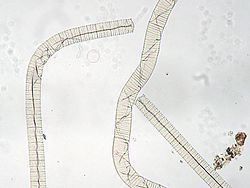Rank Species | ||
 | ||
Similar | ||
Oscillatoria princeps Vaucher ex Gomont is the type species (lectotype) of the blue green algal genus Oscillatoria.
Contents
The alga is dark blue green in colour which is due to the predominance of the pigment Phycobilins i.e. phycocyanin and phycoerythrin. Individual filaments were blue green to olive green in colour. Growth takes place only by transverse division hence the trichome comprises single row of cells stacked one above the other. Cytoplasmic sheath is present which is very thin, hyaline and not well distinct.
Mature trichome straight, cells much broader than long and has hemispherical apical cell with keritomized content . Trichome unconstricted in growth phase and constrictions were observed during reproduction. Distinct cross walls present. The size of the cells varies from 57.60 µm to 69.05 µm in width and 5.20 µm to 9.55 µm in length thus the ratio of the length and breadth as 1:8.
Stack of Poker Chips
The cells of the trichomes were round in shape and when such cells were stacked one above the other it gives "stack of poker chips " appearance characteristic feature of this species.
Crack -like nick on Filament
A crack-like nick was observed on the trichomes was found by Umarani et. al. in microscopic view. While they studying individual cells notches were found at the inner side of the cell corresponding the slit on the trichome. When such cells were stacked one above the other, it results in the crack like structure on the trichome. Thus, the number of notches in a single cell equals the number of slits on the trichome. One to three notches / slits were observed in the study by Uma Rani et al. 2015.
Reproduction
Reproduction takes place only by vegetative methods namely fragmentation and hormogonia. Both the methods were observed in the most of the study. Fragmentation takes place by the degradation of weakened cells or mechanically damaged cells. The trichome divides into smaller fragments. The cells of the fragment by repeated division develop into a new filament.
Distribution
This species is ubiquitous in distribution. it reported from both marine and freshwater.
Arctic: Ellesmere Island
Europe: Baltic Sea, Britain, Germany, Lithuania, Romania, Spain, Turkey .
Atlantic Islands: Canary Islands .
North America: Arkansas, Florida, Great Lakes, Mexico, Northwest Territories.
South America: Argentina, Brazil.
Africa: Ghana, Mozambique, Sierra Leone, Sudan.
Indian Ocean Islands: Mauritius.
South-west Asia: India, Iraq, Israel, Kuwait, Pakistan, Punjab, Saudi Arabia, Sri Lanka.
Asia: China, Korea, Nepal, Russia (Far East), South China Sea, Taiwan, Turkey (Asia).
South-east Asia: Myanmar (Burma), Thailand, Vietnam.
Australia and New Zealand: New South Wales, New Zealand, Northern Territory, Queensland, South Australia, Victoria .
